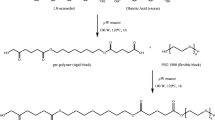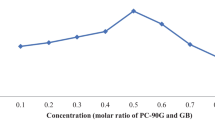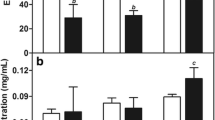Abstract
The objective of this study was to develop novel docetaxel phospholipid nanoparticles (NDPNs) for intravenous administration. Modified solvent diffusion-evaporation method was adopted in the NDPN preparation. Central composite design (CCD) was employed in the optimization of the critical formulation factor (drug content) and process variable (stirring rate) to obtain NDPNs with 215.53 ± 1.9-nm particle size, 0.329 ± 0.02 polydispersity index (PDI), and 75.41 ± 4.81% entrapment efficiency. The morphological examination by transmission electron microscopy revealed spherical structure composed of a drug core stabilized within the phospholipid shell. Enhanced cell uptake of coumarin-6-loaded phospholipid nanoparticles by MCF-7 cell line indicated NDPN-efficient cell uptake. In vitro hemolysis test confirmed the safety of the phospholipid nanoparticles. NDPNs exhibited increased area under the curve (AUC) and mean residence time (MRT) by 3.0- and 3.3-fold, respectively, in comparison with the existing docetaxel parenteral formulation (Taxotere®), indicating a potential for sustained action. Thus, the novel NDPNs exhibit an ability to be an intravenous docetaxel formulation with enhanced uptake, decreased toxicity, and prolonged activity.









Similar content being viewed by others
References
Jemal A, Bray F, Center MM, Ferlay J, Ward E, Forman D. Global cancer statistics. CA Cancer J Clin. 2011;61(2):69–90.
Mettlin C. Global breast cancer mortality statistics. CA Cancer J Clin. 1999;49(3):138–44.
Norris LB, Qureshi ZP, Bookstaver PB, Raisch DW, Sartor O, Chen H, et al. Polysorbate 80 hypersensitivity reactions: a renewed call to action. J Community Oncol. 2010;7(9):425–8.
Lee SW, Yun MH, Jeong SW, In CH, Kim JY, Seo MH, et al. Development of docetaxel-loaded intravenous formulation, nanoxel-pm using polymer-based delivery system. J Control Release. 2011;155(2):262–71.
Upadhyay KK, Bhatt AN, Castro E, Mishra AK, Chuttani K, Dwarakanath BS, et al. In vitro and in vivo evaluation of docetaxel loaded biodegradable polymersomes. Macromol Biosci. 2010;10(5):503–12.
Chen ZK, Cai MX, Yang J, Lin LW, Xue ES, Huang J, et al. Chemotherapy with PLGA microspheres containing docetaxel decreases angiogenesis in human hepatoma xenograft. Med Oncol. 2012;29(1):62–9.
Esmaeili F, Dinarvand R, Ghahremani MH, Amini M, Rouhani H, Sepehri N, et al. Docetaxel-albumin conjugates: preparation, in vitro evaluation and biodistribution studies. J Pharm Sci. 2009;98(8):2718–30.
Hwang HY, Kim IS, Kwon IC, Kim YH. Tumor targetability and antitumor effect of docetaxel-loaded hydrophobically modified glycol chitosan nanoparticles. J Control Release. 2008;128(1):23–31.
Liu Y, Li K, Pan J, Liu B, Feng SS. Folic acid conjugated nanoparticles of mixed lipid monolayer shell and biodegradable polymer core for targeted delivery of docetaxel. Biomaterials. 2010;31(2):330–8.
Loxley A. Solid lipid nanoparticles for the delivery of pharmaceutical actives. Drug Deliv Technol 2009;9(8).
Musumeci T, Ventura CA, Giannone I, Ruozi B, Montenegro L, Pignatello R, et al. PLA/PLGA nanoparticles for sustained release of docetaxel. Int J Pharm. 2006;325(1–2):172–9.
Qiu Y, Gao Y, Hu K, Li F. Enhancement of skin permeation of docetaxel: a novel approach combining microneedle and elastic liposomes. J Control Release. 2008;129(2):144–50.
Yousefi A, Esmaeili F, Rahimian S, Atyabi F, Dinarvand R. Preparation and in vitro evaluation of a pegylated nano-liposomal formulation containing docetaxel. Sci Pharm. 2009;77:453–64.
Zhai G, Wu J, Xiang G, Mao W, Yu B, Li H, et al. Preparation, characterization and pharmacokinetics of folate receptor-targeted liposomes for docetaxel delivery. J Nanosci Nanotechnol. 2009;9(3):2155–61.
Pavan KB, Subhashis D, Niranjan BM. Pharmacosomes as a novel vesicular drug delivery system. Int J Noval Trends Pharml Sci. 2013;3(3):46–52.
Semalty A, Semalty M, Rawat BS, Singh D, Rawat MS. Pharmacosomes: the lipid-based new drug delivery system. Expert Opin Drug Deliv. 2009;6(6):599–612.
Singh C, Bhatt TD, Gill MS, Suresh S. Novel rifampicin-phospholipid complex for tubercular therapy: synthesis, physicochemical characterization and in-vivo evaluation. Int J Pharm. 2014;460(1–2):220–7.
Fang J, Nakamura H, Maeda H. The epr effect: unique features of tumor blood vessels for drug delivery, factors involved, and limitations and augmentation of the effect. Adv Drug Deliv Rev. 2011;63(3):136–51.
Iyer AK, Khaled G, Fang J, Maeda H. Exploiting the enhanced permeability and retention effect for tumor targeting. Drug Discov Today. 2006;11(17–18):812–8.
Singh G, Pai RS. Optimized self-nanoemulsifying drug delivery system of atazanavir with enhanced oral bioavailability: in vitro/in vivo characterization. Expert Opin Drug Deliv. 2014;11(7):1023–32.
Larabi M, Gulik A, Dedieu JP, Legrand P, Barratt G, Cheron M. New lipid formulation of amphotericin b: spectral and microscopic analysis. Biochim Biophys Acta. 2004;1664(2):172–81.
Larabi M, Yardley V, Loiseau PM, Appel M, Legrand P, Gulik A, et al. Toxicity and antileishmanial activity of a new stable lipid suspension of amphotericin b. Antimicrob Agents Chemother. 2003;47(12):3774–9.
Li X, Wang D, Zhang J, Pan W. Preparation and pharmacokinetics of docetaxel based on nanostructured lipid carriers. J Pharm Pharmacol. 2009;61(11):1485–92.
Huang XX, Zhou CL, Wang H, Chen C, Yu SQ, Xu Q, et al. Pharmacokinetics, efficacy, and safety evaluation of docetaxel/hydroxypropyl-sulfobutyl-beta-cyclodextrin inclusion complex. AAPS Pharmscitech. 2011;12(2):665–72.
Mora-Huertas CE, Fessi H, Elaissari A. Influence of process and formulation parameters on the formation of submicron particles by solvent displacement and emulsification-diffusion methods critical comparison. Adv Colloid Interf Sci. 2011;163(2):90–122.
Singare DS, Marella S, Gowthamrajan K, Kulkarni GT, Vooturi R, Rao PS. Optimization of formulation and process variable of nanosuspension: an industrial perspective. Int J Pharm. 2010;402(1–2):213–20.
Papadopoulou V, Kosmidis K, Vlachou M, Macheras P. On the use of the weibull function for the discernment of drug release mechanisms. Int J Pharm. 2006;309(1–2):44–50.
Adibkia K, Siahi Shadbad MR, Nokhodchi A, Javadzedeh A, Barzegar-Jalali M, Barar J, et al. Piroxicam nanoparticles for ocular delivery: physicochemical characterization and implementation in endotoxin-induced uveitis. J Drug Target. 2007;15(6):407–16.
Rivolta I, Panariti A, Lettiero B, Sesana S, Gasco P, Gasco MR, et al. Cellular uptake of coumarin-6 as a model drug loaded In solid lipid nanoparticles. J Physiol Pharmacol. 2011;62(1):45–53.
Gao H, Yang Z, Zhang S, Cao S, Shen S, Pang Z, et al. Ligand modified nanoparticles increases cell uptake, alters endocytosis and elevates glioma distribution and internalization. Sci Rep. 2013;3:1–8.
Fang G, Tang B, Liu Z, Gou J, Zhang Y, Xu H, et al. Novel hydrophobin-coated docetaxel nanoparticles for intravenous delivery: in vitro characteristics and in vivo performance. Eur J Pharm Sci. 2014;60:1–9.
Acknowledgments
The authors wish to express their gratitude to the Mr. Ashok K. Datusalia, Piyush Dave, Prashant Gupta (Department of Pharmacology and Toxicology), and Charan Singh (Department of Pharmaceutical Technology) for their valuable support in conducting the animal studies. We thank Lipoid (GmbH, Germany) for providing gift samples of phospholipids.
Author information
Authors and Affiliations
Corresponding author
Rights and permissions
About this article
Cite this article
Yadav, D.K., Pawar, H., Wankhade, S. et al. Development of Novel Docetaxel Phospholipid Nanoparticles for Intravenous Administration: Quality by Design Approach. AAPS PharmSciTech 16, 855–864 (2015). https://doi.org/10.1208/s12249-014-0274-9
Received:
Accepted:
Published:
Issue Date:
DOI: https://doi.org/10.1208/s12249-014-0274-9




